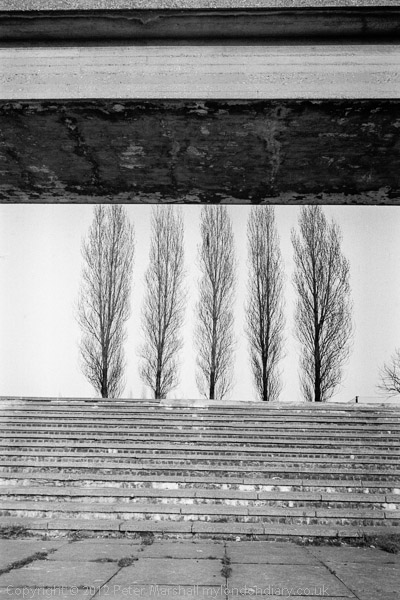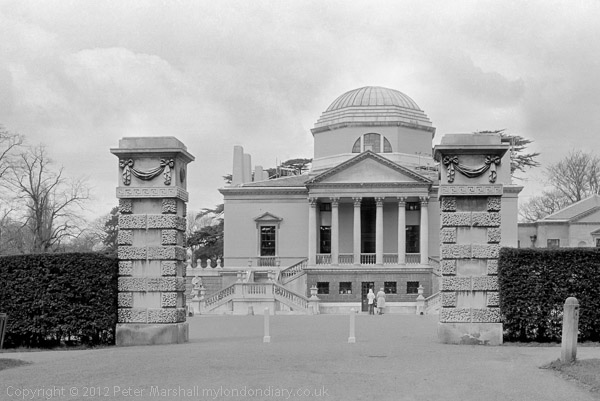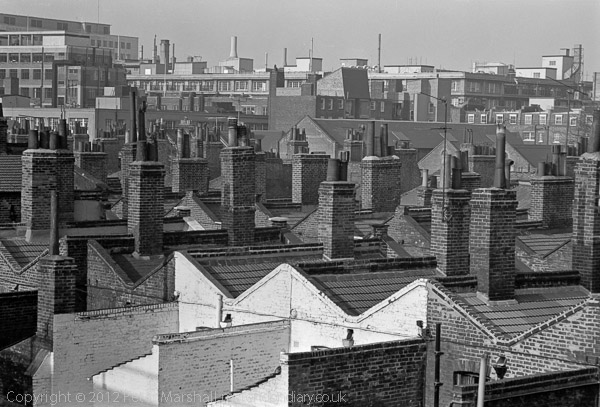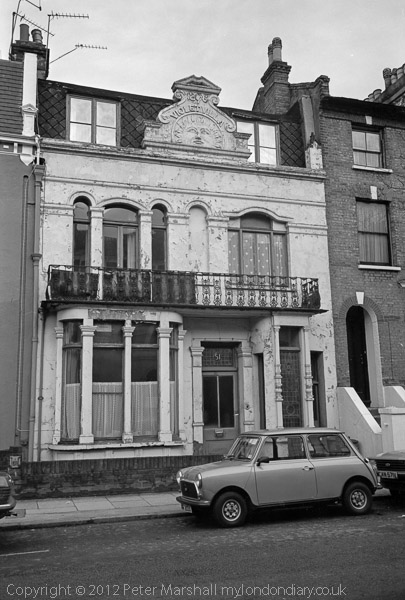Until I read a three part article on the Pepys Estate at Deptford published in ‘The London Column‘ I wasn’t aware that the work which Tony Ray-Jones took for the Architectural review was now in the RIBA photographic library.

Pepys Estate, 1982. Peter Marshall
The first of three posts on the Pepys Estate, Deptford links to BBC archive footage of a remarkable programme first broadcast in 1969, Bird’s Eye View – The Englishman’s Home – shot mainly from a helicopter with commentary by John Betjeman who refused to fly, but worked with the footage as it was edited. Rather slow-moving by modern standards, though Betjeman is always a pleasure to listen to, unless you have a strong stomach for the sentimental and picturesque you might like to skip the first thirty-something minutes where inevitably it lingers far too long over many stately homes, and omits the true history of misery, repression and exploitation behind their architectural splendour. Ground-breaking it claims to be for its aerial perspective, but the approach is comfortable and conservative in its politics.

Chiswick House, 1977. Peter Marshall
After a brief trip to fairy-tale Wales at around 30 minutes the programme shifts first to Chiswick House in Betjemans beloved Middlesex, before moving to truly urban housing in Bath “in the crater of an extinct volcano” and then Clifton in Bristol, built when it was the second city of England (built on the unmentioned slave trade) then on to Brighton, our best-looking seaside town. The helicopter (and commentary) concentrate on the Georgian terraces of the 1830s before zooming down to the Pavillion.
Next come a couple of ‘model’ villages built on some of the huge estates – including the single house left in the old village at Chatsworth that had spoiled his Lordships view and Edensor built up the hill for his tenants: “I can’t see why this sort of thing is any more inhuman than what a council does today“. I can.
Then its comfortable North Oxford and swimming pool suburbs, “the sort of house that everybody wants, an acre and a garden and no cow“. Finally at 39 minutes we get to Port Sunlight “a protest against northern back to backs” (which don’t get shown), and on to Peacehaven. Betjeman comments on the snootiness about this cliff-top development, but his defence of it seems to be based more on a wish to stand out from the architectural crowd than any real knowledge of the place – to which two of my aunts moved to die around the time the programme was made.
At 42 minutes comes Harlow New Town (“do you think this is the way we ought to live and do as we are told)” and on to a new Lyons estate at New Ash Green in greenfield Kent, then at 44 minutes, Docklands and high rise, with brief glimpses of the Royal Docks and Roehampton. The programme ends with the Pepys estate: “But where can be the heart that sends a family to the 20th floor of such a slab as this … .caged halfway up the sky… what is housing if it’s not a home” and the wide cleared site for Thamesmead with a its early blocks under contsctuction – “how human will it be?” asks Betjeman.
The image by Tony Ray-Jones, ‘Pepys Estate, Deptford, 1970‘ brings us back very much into the real world of a group of young kids playing on the estate, as does the text by Owen Hatherley and the further picture by Ray-Jones on part two of the series. In part three. Robert Elwall writes about the work commissioned by Hubert de Cronin Hastings, owner of the Architectural Press and editor of its leading journal, the Architectural Review from Ray-Jones and some other leading photographers in a series entitled ‘Manplan‘ which ran 8 themed monthly issues from September 1969 to September 1970 and its place in the history of architectural photography. Ray-Jones’ contribution was in the last of these, ‘Manplan 8: Housing‘ and perhaps the final straw; it was an experiment too much for many of the magazine’s subscribers and had to be abandoned.

Waterloo, 1980. Peter Marshall
Searching in the RIBA Photo Library using the term ‘Ray-Jones’ returns 167 images by him (rather more than the 138 mentioned on The London Column), from the Pepys Estate, from Lillington Gardens in Pimlico, from Haringey, Thamesmead, the Old Kent Rd, Blackheath, Battersea, Southwark, Crawley and New Ash Green and elsewhere and includes architect designed small houses as well as council estates.
The most interesting pictures to me are those of children playing around the estates at Thamesmead and Hammersmith and particularly in the Pepys Estate at Deptford, which appears to have occupied him more than the other sites. Some of the work seems straightforward architectural work – and at times similar to images I and many others have taken of similar subjects (and frankly there are a few that are a little boring), but the work comes alive once he found people to include in the picture – and there are a few where there is no visible architecture.

Violet Villa 1896, Putney, 1982. Peter Marshall
But his purely architectural work – like much of that genre – often leaves me cold. Too often the pictures are of idealised structures, everything clean and tidy, with the emphasis on new buildings, pristine and unlived in. I suspect like me, Ray-Jones was truly more interested in the lived in, buildings that have developed a character through use – and abuse. Too often architectural photographs look like pictures of models rather than the real world, and although I’ve spent a lot of time photographing buildings, I’ve never called myself an architectural photographer.
I’ve written here before on some of the issues over housing, and in particular the privatisation of estates such as the Pepys Estate, and it was good to read Owen Hatherly’s piece. You can read some of my own thoughts in Views of Deptford and on posts about the Carpenters Estate (Around the Olympics) in Stratford and the Heygate Estate (Southwark’s Shame) at the Elephant.
The three pictures illustrating this piece are from my own archive, and include some which will appear in the books I’m currently working on from my pictures of London in 1970-85.
________________________________________________________
My London Diary : Buildings of London : River Lea/Lee Valley : London’s Industrial Heritage
All photographs on this and my other sites, unless otherwise stated are by Peter Marshall and are available for reproduction or can be bought as prints.
To order prints or reproduce images
________________________________________________________